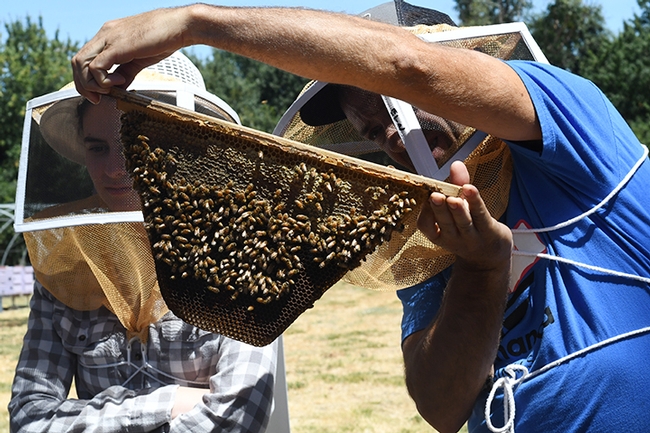
Extension apiculturist Elina Lastro Niño of the UC Davis Department of Entomology and Nematology faculty and director of the UC Davis-based California Master Beekeeper Program (CAMPB) teaches classes with her lab associates throughout much of the year.
Participants agree that the classes are "the bees' knees," a phrase which means they're excellent, of the highest quality.
One of the most recent classes, "Planning Ahead for Your First Hives," drew the maximum of 23 participants at the Harry H. Laidlaw Jr. Honey Bee Research Facility on Bee Biology Road.
The group spent a Saturday learning all about honey bees via lectures and hands-on activities.They learned bee biology, components of the hive, where to place the hive, and how to plan for their first hive--all under the tutelage and watchful eyes of the two Niños: Elina Lastro Niño and husband/beekeeper Bernardo Niño, who is the CAMPB educational program supervisor and a staff research assistant in the E. L. Niño lab.
Then the participants donned bee veils and stepped outside to the apiary to learn hive inspection basics. They returned to the classroom for lunch and a Powerpoint presentation on "Keeping Bees Year-Around."
Highlights included opening a hive and engaging in queen wrangling, hands-on activities (holding a frame and identifying the queen, worker bees and drones), and varroa mite monitoring. The participants also examined several different types of the hives in the apiary, including the traditional Langstroth hive, Kenya top bar hive or horizontal top bar-hive, Warré hive and a flow hive. The short course ended with a session on "Save us from the hive intruders!" and a question-and-answer period.
The next day CAMPB hosted another short course, this one on "Working Your Colonies." Participants learned what is necessary to maintain a healthy colony. Lectures covered advanced honey bee biology, honey bee integrated pest management, and products of the hive. The group also learned about queen wrangling, honey extraction, splitting/combined colonies, and monitoring for varroa mites.
Both courses drew maximum enrollment. "The classes were excellent," commented Wendy Mather, program manager of CAMPB. "We received really great feedback and the participants were thrilled to get the in-hive experience. And we got to sample some melipona honey (from stingless bees) from the Yucatán, as one of our participants had recently returned from a trip there."
The participants "now have some science-based knowledge and skills about honey bees and beekeeping that they can confidently share," Mather said. CAMPB uses science-based information to educate stewards and ambassadors for honey bees and beekeeping.
Next Class: Varroa Mite Management Strategies
The next beekeeping class? "Varroa Mite Management Strategies" from 9 a.m. to 4 p.m., Sunday, Oct. 13 at the Laidlaw facility. Participants will learn how to monitor, mitigate and manage the pests.
"Current beekeeping challenges call for all beekeepers to have a solid understanding of varroa mite biology and management approaches," said Elina Lastro Niño, in describing the course. "We will dive deeper into understanding varroa biology and will devote majority of the time to discussing pros and cons of various means to monitor, mitigate, and manage this crucial honey bee pest."
Niño, who serves as the state's Extension apiculturst, is known for her expertise on honey bee queen biology, chemical ecology, and genomics. She holds a doctorate in entomology from Pennsylvania State University (PSU), where she served as a postdoctoral fellow in the lab of Christina Grozinger, director of the PSU Center for Pollinator Research.
The course, limited to 20 participants, will cover varroa biology, treatment options and chemical-free options. Participants are to bring their bee veil or suit. The $200 registration fee covers the cost of course materials, lunch and refreshments. The last day to register is Monday, Oct. 7. Click here to register.
The eight-legged varroa mite (Varroa destructor) is an external parasite that attacks and feeds on honey bees. The female is reddish brown, while the male is white. They measure 1–1.8 mm long and 1.5–2 mm wide. Originating in Asia, varroa mites are now found throughout most of the world. Scientists first detected the pest in the United States in 1987.
For more information on the varroa mite course or other CAMPB courses, access the website or contact Mather at wmather@ucdavis.edu.
Attached Images:
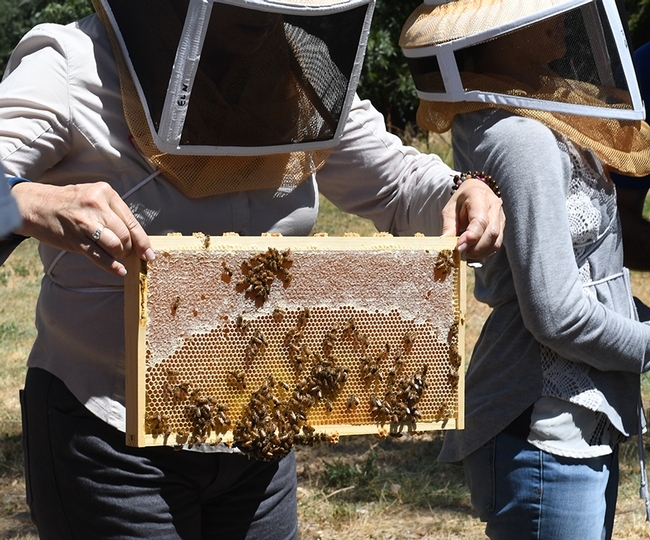
A student in the UC Davis class, "Planning Ahead for Your First Hive," holds a frame. (Photo by Kathy Keatley Garvey)
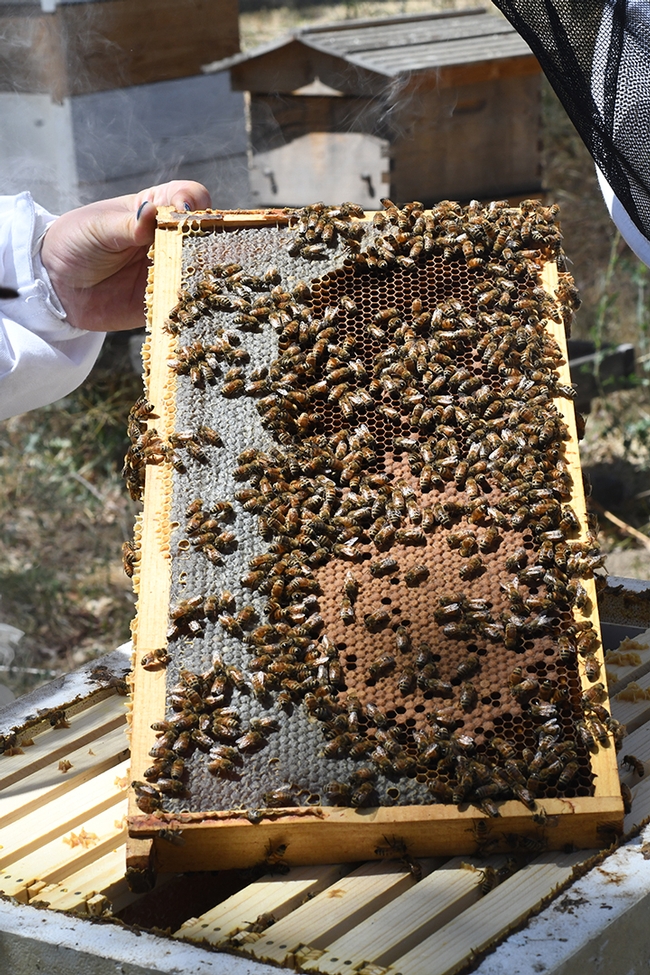
Close-up of a frame. (Photo by Kathy Keatley Garvey)
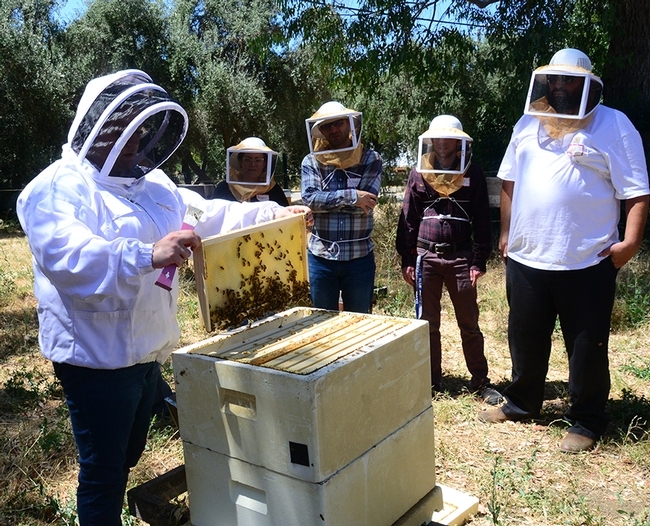
Extension apiculturist Elina Lastro Niño opens a hive as the students gather around. (Photo by Kathy Katley Garvey)
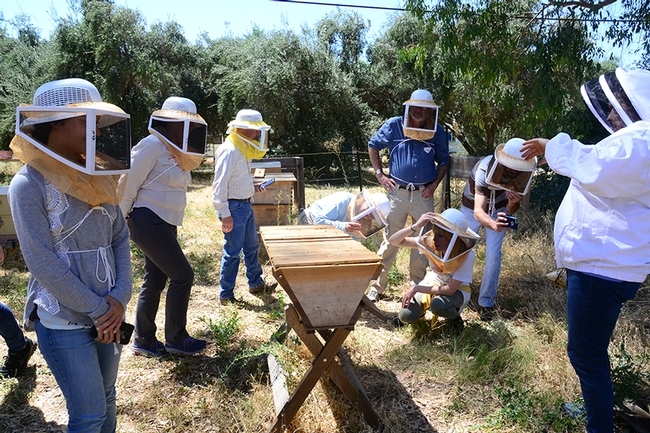
Participants in the UC Davis class, "Planning for Your First Hive," learn about the top bar hive. (Photo by Kathy Keatley Garvey)
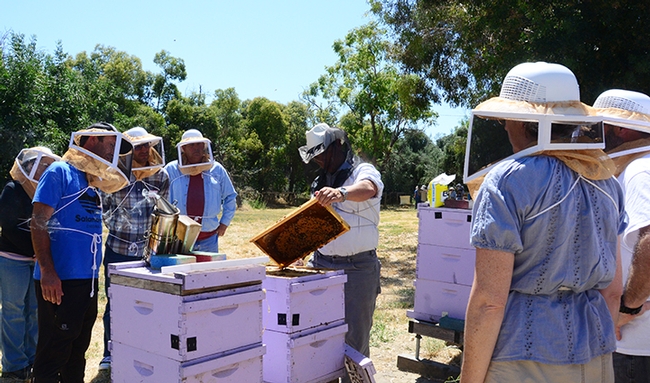
UC Davis research assistant Bernardo Niño examines a frame. He is the educational supervisor for the California Master Beekeeper Program, which conducts bee classes. (Photo by Kathy Keatley Garvey)
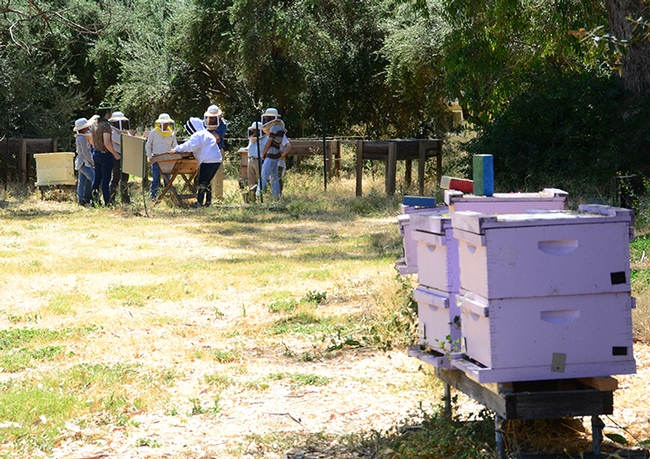
A hive in the foreground is teeming with bees. In the background, students in a UC Davis class learn about bees. (Photo by Kathy Keatley Garvey)